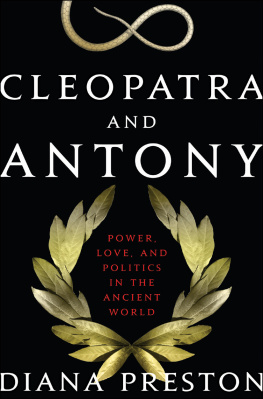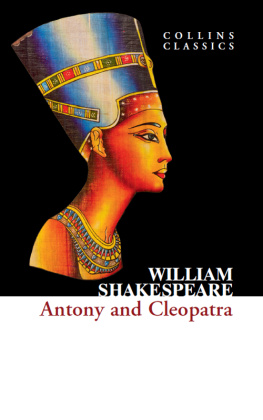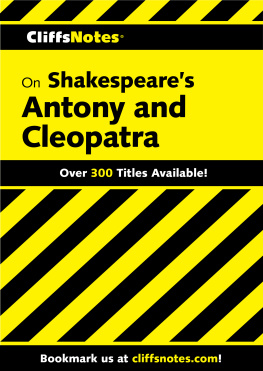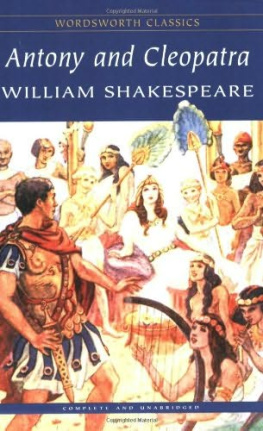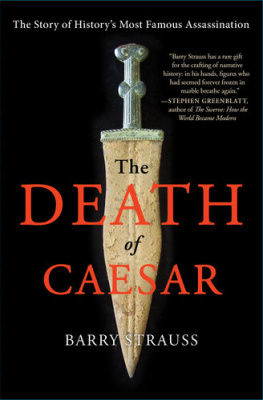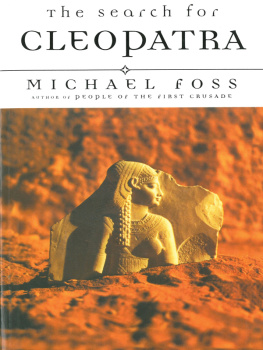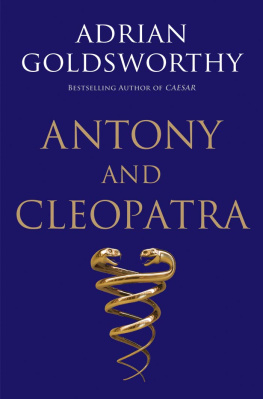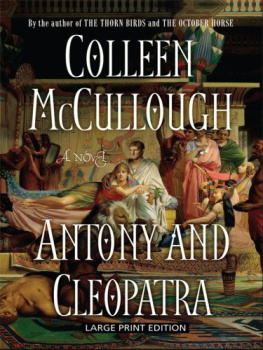Copyright 2005 by Taylor & Francis Books, Inc.
Routledge is an imprint of the Taylor & Francis Group.
This edition published in the Taylor & Francis e-Library, 2005.
To purchase your own copy of this or any of Taylor & Francis or Routledges collection of thousands of eBooks please go to www.eBookstore.tandf.co.uk.
All rights reserved. No part of this book may be reprinted or reproduced or utilized in any form or by any electronic, mechanical, or other means, now known or hereafter invented, including photocopying and recording, or in any information storage or retrieval system, without permission in writing from the publishers.
Library of Congress Cataloguing-in-Publication Data is available from the Library of Congress.
Acknowledgments
This book is the result of many years of reading about and teaching Antony and Cleopatra. Many individuals and institutions have contributed to the completion of this study and I would like to acknowledge at least some of them at this time.
First and foremost, my gratitude to my thirteen contributors for their innovative and inspirational essays oerflows the measure. I am confident that these original essays, written especially for this anthology, through the variety of their subject matter and the diversity of their critical approaches, will significantly expand the critical contexts within which this vast and wonderful drama can be read, viewed, and analyzed.
I would also like to express my appreciation to the Chairperson of my Department, Phillip Sipiora, who offered continual support, both psychological and financial, for this project. In addition, I would like to thank the Sabbatical Committee at the University of South Florida, which granted me the research time absolutely necessary for the completion of this endeavor, and the USF Publications Council, which contributed funds to support this project. David Fuller also would like to acknowledge substantial financial support from the British Academy in carrying out the archival research for his essay.
I also am grateful to all of the librarians, curators, and theater personnel who graciously and tirelessly assisted me in finding necessary research material and illustrations for this collection. These include the library staff of the University of South Florida; Kathleen Coleman of the Harvard Theatre Collection; Janet Birkett of the London Theatre Museum; Audrey Hall of the National Museums of Liverpool; Stacy Bemento of the Philadelphia Museum of Art; Sylvia Morris, Marian Pringle, Susan Brock, and Helen Hargest of the Shakespeare Centre Library in Stratford-upon-Avon; Martin Durrant of the V&A Picture Library in London; Emily Schulze of the Alley Theatre in Houston, Texas; Jo Phillips of the Globe Theatre in London; Amy Richard of the Oregon Shakespeare Festival in Ashland, Oregon; Abigail Jones of the Royal National Theatre in London; David Howells and Jane Ellis of the Royal Shakespeare Theatre in Stratford-upon-Avon; Catherine Taylor-Williams of Shakespeare & Company in Lenox, Massachusetts; Jo-Anne Jordan of the Shakespeare Festival of Canada in Stratford, Ontario; and Liza Holtmeier of the Shakespeare Theatre, Washington, DC. Particular thanks go to Giles Block, director of the 1999 production of Antony and Cleopatra for the Globe Theatre, London, who found time from his taxing schedule to grant Georgia E. Brown the interview that concludes this volume.
My deepest appreciation also goes to my editors at Routledge, Matthew Byrnie and Prudy Taylor Board, for their beneficial aid and advice throughout this endeavor, and to my superconscientious and organized research assistant, Robin Rogers, who indefatigably searched libraries and the Web for necessary materials, checked my multitudinous citations, and scrupulously proofread and formatted this manuscript.
I also am deeply indebted to my friends and colleagues, Shelia Diecidue, Robert A. Logan, and Merry Perry, who labored over the introduction to this collection and offered many valuable and perceptive comments, and also to Philip C. Kolin, general editor of this series, who first enlisted me as the editor of this collection and whose consistent support sustained me throughout the long hours of reading and editing.
Finally, most of all, I wish to thank my husband, Gordon Deats, my own paragon of husbands, whose encouragement throughout my scholarly career, like Antonys bounty, has no winter in it, but grows the more with reaping.
1. Shakespeares Anamorphic Drama: A Survey of Antony and Cleopatra in Criticism, on Stage, and on Screen
SARA MUNSON DEATS
MARS OR GORGON
Of all Shakespeares problematic plays, I find Antony and Cleopatra to be his most anamorphic drama, a judgment validated by 350 years of vehemently conflicting interpretations. For the almost four centuries since its composition, critical controversy has seethed around every aspect of the tragedyits value, its ethos, its genre, its structure, and its characters.
First, few of Shakespeares tragedies have been both so admired and so disparaged. Samuel Taylor Coleridge (181334) extols


